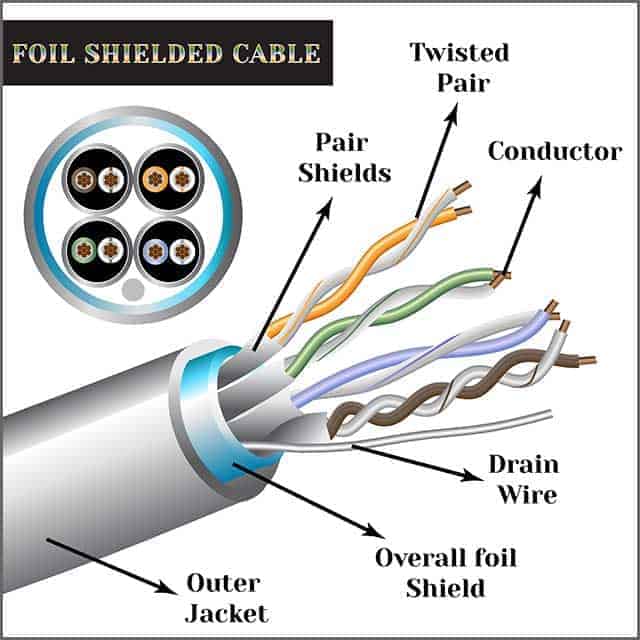The shielded wiring system originates from Europe, which adds a metal shield to the outside of the ordinary unshielded wiring system and uses the reflection, absorption, and skin effect of the metal shield to achieve the function of preventing electromagnetic interference and electromagnetic radiation. The shielded system makes comprehensive use of the balance principle of the twisted pair and the shielding effect of the shield and thus has very good electromagnetic compatibility (EMC) characteristics.
Electromagnetic compatibility (EMC) refers to the electronic equipment or network system having a certain ability to resist electromagnetic interference, while not generating excessive electromagnetic radiation. In other words, the equipment or network system is required to work normally in a relatively harsh electromagnetic environment, while not radiating excessive electromagnetic waves to interfere with the normal work of other devices and networks around.
The balance characteristics of U/UTP (unshielded) cables do not depend only on the quality of the components themselves (such as stranded pairs), but can be influenced by the surrounding environment. The metal around the U/UTP (unshielded), the hidden "ground", the pulling and bending during the construction, etc. can destroy the balance characteristics and thus reduce the EMC performance.
Therefore, there is only one solution to obtain long-lasting balanced characteristics: grounding all cores with an additional layer of aluminum foil. The aluminum foil adds protection to the fragile twisted cores and creates an artificially balanced environment for U/UTP (unshielded) cables. This results in what we now call a shielded cable.
The shielded cable shielding principle is different from the twisted balance offset principle, shielded cable is in the four pairs of twisted wire outside the addition of an extra layer or two layers of aluminum foil, the use of metal reflection of electromagnetic waves, absorption and skin effect principle (the so-called skin effect refers to the distribution of current in the conductor cross-section with the increase in frequency and tend to conductor surface distribution, the higher the frequency, the smaller the skin depth, that is, the higher the frequency, the weaker the penetration ability of electromagnetic waves), to effectively prevent external electromagnetic interference. ), effectively prevent external electromagnetic interference into the cable, but also prevent internal signal radiation, from interfering with the work of other equipment.
Experiments show that electromagnetic waves with a frequency of more than 5MHz can only pass through 38μm thick aluminum foil. If the thickness of the shield is allowed to exceed 38μm, it makes the frequency of electromagnetic interference that can enter the inside of the cable through the shield mainly below 5MHz. The low-frequency interference below 5MHz can be effectively offset by applying the balancing principle of twisted-pair cables.
According to the earliest definition of cabling, there are two types of unshielded cables - UTP and shielded cables - STP. Later, with the development of technology and different processes, many different types of shielding have been derived 1. b) S/FTP (PIMF) single pair of aluminum foil shield plus copper braid wrapped in the outer layer of four pairs of wires PIMF =Pair in Metal Foil.
Shielded cables resist external interference mainly because the integrity of the signal transmission can be guaranteed by the shielding system. A shielded cabling system can prevent the transmission of data from external electromagnetic interference and radio frequency interference. Electromagnetic interference (EMI) is mainly low-frequency interference, motors, fluorescent lamps, and power lines are the usual sources of electromagnetic interference. Radio Frequency Interference (RFI) is high-frequency interference, mainly radio frequency interference, including radio, television transmissions, radar, and other wireless communications.
For resistance to electromagnetic interference, the choice of woven layer shielding is most effective, that is, metal mesh shielding, because it has a low critical resistance. And for RF interference, metal foil layer shielding is most effective because the gaps created by the metal mesh shielding allow high-frequency signals to move freely in and out. For mixed high and low-frequency interference fields, it is necessary to use a combination of metal foil layer plus metal mesh shielding, that is, S/FTP form of double-shielded cable, which can make the metal mesh shielding for a low-frequency range of interference, metal foil shielding for a high-frequency range of interference.
IBM ACS shielding cable in the aluminum foil shielding layer thickness of a single layer that is 50-62μm, to play a more complete shielding effect. At the same time, due to the use of only a single layer of shielding, the construction will be simpler, easier to install, less likely to cause human damage during construction, and the thickness of aluminum foil can withstand greater destructive forces. Thus can provide users with higher-quality transmission performance.



